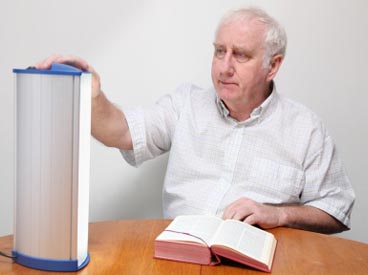Does light therapy really cure winter depression? The answer is a qualified yes.
Clinical studies prove that light box therapy helps about eight in ten people with winter depression. The condition, also known as seasonal affective disorder (SAD) is characterized by oversleeping, fatigue, change in appetite, and feelings of hopelessness. These symptoms often improve within days or weeks of daily 30-minute, early morning light therapy sessions.
Individuals sit a couple feet away from a light box equipped with diffusing screen and special bulbs while reading, doing a hobby, or eating a meal. How does it work? There are lots of theories, but little clear evidence.
“Exposing the eyes to indirect bright light changes blood levels of melatonin that may reset the body’s internal clock and improve symptoms,” says psychiatrist and author Stephanie Mullany. “Is it hormones? Nerves? It’s like a pile of pick-up sticks, and we have much to learn.”
Light therapy boxes for winter depression are available without a prescription at drug, hardware, and online stores. The units are considered safe for easing mild symptoms in most adults—the main exception being those who take medicines that make the skin especially sensitive to light. (See “Before You Buy” for shopping tips.)
People with any type of depression should always talk to a qualified health professional about treatment and prevention options, including antidepressant medications and talk therapy.
SAD Light Box Basics
- Light boxes cost between $100 and $500.
- Light boxes are up to 30 times brighter than standard home lighting fixtures.
- Light boxes treat SAD by emitting visible rays that are registered by the eyes—rather than those ultraviolet (UV) rays that penetrate and damage the skin.
Before You Buy
- Ask your doctor for specific product recommendations.
- Get a doctor’s prescription if your insurance company requires one to cover the cost.
- Check your pill bottles for a yellow sun sticker, or ask a pharmacist if your medicines might you to be overly sensitive to bright light. If so, you may be ineligible for light therapy or require special precautions.
- Shop around to find the light intensity, cost, and style that best suit your needs. Independent retailer Light Therapy Products offers a helpful summary to get you started.
Stephanie Mullany, M.D. is author of Give and Take: A Roadmap to Understanding a Psychiatrist copyright 2011, published by iUniverse, Bloomington, Indiana.
Become a Saturday Evening Post member and enjoy unlimited access. Subscribe now



